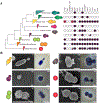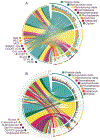Cultivation and functional characterization of 79 planctomycetes uncovers their unique biology
- PMID: 31740763
- PMCID: PMC7286433
- DOI: 10.1038/s41564-019-0588-1
Cultivation and functional characterization of 79 planctomycetes uncovers their unique biology
Abstract
When it comes to the discovery and analysis of yet uncharted bacterial traits, pure cultures are essential as only these allow detailed morphological and physiological characterization as well as genetic manipulation. However, microbiologists are struggling to isolate and maintain the majority of bacterial strains, as mimicking their native environmental niches adequately can be a challenging task. Here, we report the diversity-driven cultivation, characterization and genome sequencing of 79 bacterial strains from all major taxonomic clades of the conspicuous bacterial phylum Planctomycetes. The samples were derived from different aquatic environments but close relatives could be isolated from geographically distinct regions and structurally diverse habitats, implying that 'everything is everywhere'. With the discovery of lateral budding in 'Kolteria novifilia' and the capability of the members of the Saltatorellus clade to divide by binary fission as well as budding, we identified previously unknown modes of bacterial cell division. Alongside unobserved aspects of cell signalling and small-molecule production, our findings demonstrate that exploration beyond the well-established model organisms has the potential to increase our knowledge of bacterial diversity. We illustrate how 'microbial dark matter' can be accessed by cultivation techniques, expanding the organismic background for small-molecule research and drug-target detection.
Figures






References
-
- Wiegand S, Jogler M & Jogler C On the maverick Planctomycetes. FEMS Microbiol. Rev 42, 739–760 (2018). - PubMed
-
- Wagner M & Horn M The Planctomycetes, Verrucomicrobia, Chlamydiae and sister phyla comprise a superphylum with biotechnological and medical relevance. Curr. Opin. Biotechnol 17, 241–249 (2006). - PubMed
-
- Peeters SH & van Niftrik L Trending topics and open questions in anaerobic ammonium oxidation. Curr. Opin. Chem. Biol 49, 45–52 (2018). - PubMed
Publication types
MeSH terms
Substances
Grants and funding
LinkOut - more resources
Full Text Sources
Other Literature Sources

